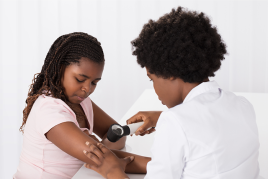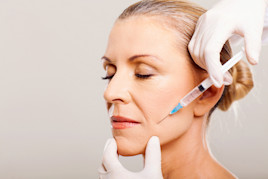Keratosis pilaris: Self-care
How to treat keratosis pilaris at home
Keratosis pilaris causes tiny, rough feeling bumps to appear on the skin, most often on the upper arms and thighs. While treatment isn’t necessary for keratosis pilaris, if the itch, dryness, or appearance bother you, board-certified dermatologists recommend these tips.
Treating keratosis pilaris at home
Some people see clearer skin by treating their keratosis pilaris at home. This three-step plan may be all you need. Dermatologists recommend following this plan every day until you see clearer skin.
Exfoliate gently. When you exfoliate your skin, you remove the dead skin cells from the surface. You can slough off these dead cells gently with a loofah, buff puff, or rough washcloth. Avoid scrubbing your skin, which tends to irritate the skin and worsen keratosis pilaris.
Apply a product called a keratolytic. After exfoliating, apply this skin care product. It, too, helps remove the excessive buildup of dead skin cells. Another name for this product is chemical exfoliator.
Slather on moisturizer. Using a keratolyic dries the skin, so you’ll want to apply a moisturizer afterwards. Dermatologists recommend using an oil-free cream or ointment to help prevent clogged pores.
Take care to use a keratolytic exactly as described in the directions. Applying too much or using it more often than indicated can cause raw, irritated skin.
Keratosis pilaris can be stubborn. If it remains despite home treatment, seeing a dermatologist can help.
Tips to prevent flare-ups
Moisturize your skin: Keratosis pilaris often flares when the skin becomes dry. Applying a moisturizer can prevent dry skin.
For best results when using a moisturizer:
- Select a thick oil-free cream or ointment rather than a lotion
- Use a moisturizer that contains urea or lactic acid
- Apply it to damp skin within 5 minutes of bathing
- Slather it on when your skin feels dry
Rethink hair removal: Shaving or waxing skin with keratosis pilaris can cause more bumps. Laser hair removal can remove the hair without causing a flare-up.
Take short showers and baths: To prevent drying your skin, take a short (20 minutes or less) bath or shower and use warm rather than hot water. Also, limit bathing to once a day.
Use a mild cleanser: Bar soap can dry your skin.
Skip the self-tanner: These tend to make the bumps more obvious rather than hide them.
Plug in a humidifier when the air feels dry: This can help prevent dry skin.
Reference
Last updated: 6/23/21
 Molluscum contagiosum: How to safely treat it
Molluscum contagiosum: How to safely treat it
 Biosimilars: 14 FAQs
Biosimilars: 14 FAQs
 Practice Safe Sun
Practice Safe Sun
 Relieve uncontrollably itchy skin
Relieve uncontrollably itchy skin
 Fade dark spots
Fade dark spots
 Untreatable razor bumps or acne?
Untreatable razor bumps or acne?
 Laser hair removal
Laser hair removal
 Scar treatment
Scar treatment
 Botox
Botox
 Free materials to help raise skin cancer awareness
Free materials to help raise skin cancer awareness
 Dermatologist-approved lesson plans, activities you can use
Dermatologist-approved lesson plans, activities you can use
 Find a Dermatologist
Find a Dermatologist
 What is a dermatologist?
What is a dermatologist?